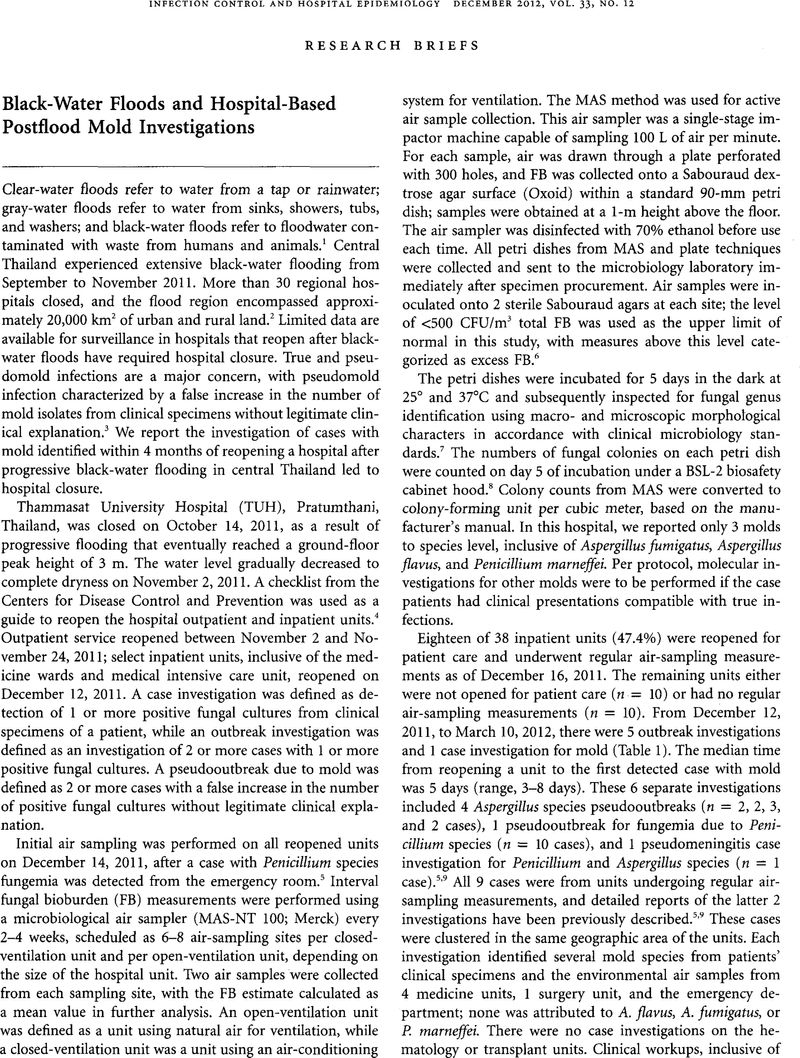Crossref Citations
This article has been cited by the following publications. This list is generated based on data provided by Crossref.
Apisarnthanarak, Anucha
Khawcharoenporn, Thana
and
Mundy, Linda M.
2012.
Air Quality of a Hospital after Closure for Black-Water Flood: An Occupational-Health Concern?.
Infection Control & Hospital Epidemiology,
Vol. 33,
Issue. 12,
p.
1285.
Apisarnthanarak, Anucha
Warren, David K.
and
Glen Mayhall, Clovus
2013.
Healthcare-associated infections and their prevention after extensive flooding.
Current Opinion in Infectious Diseases,
Vol. 26,
Issue. 4,
p.
359.
Apisarnthanarak, Anucha
Mundy, Linda M.
Khawcharoenporn, Thana
and
Mayhall, C. Glen
2013.
Hospital Infection Prevention and Control Issues Relevant to Extensive Floods.
Infection Control & Hospital Epidemiology,
Vol. 34,
Issue. 2,
p.
200.
Ling, Moi Lin
Apisarnthanarak, Anucha
Thu, Le Thi Anh
Villanueva, Victoria
Pandjaitan, Costy
and
Yusof, Mohamad Yasim
2015.
APSIC Guidelines for environmental cleaning and decontamination.
Antimicrobial Resistance and Infection Control,
Vol. 4,
Issue. 1,
Sood, Geeta
Vaidya, Dhananjay
Dam, Lisa
Grubb, Lisa M.
Zenilman, Jonathan
Krout, Kelly
Khouri-Stevens, Zeina
Bennett, Richard
Blanding, Renee
Riedel, Stefan
Milner, Stephen
Price, Leigh Ann
and
Perl, Trish M.
2018.
A polymicrobial fungal outbreak in a regional burn center after Hurricane Sandy.
American Journal of Infection Control,
Vol. 46,
Issue. 9,
p.
1047.
Precha, Nopadol
Kliengchuay, Wissanupong
Woo, Cheolwoon
Yamamoto, Naomichi
and
Tantrakarnapa, Kraichat
2020.
Fungal Assemblages on Indoor Surfaces with Visible Mold Growth in Homes after the 2016 Flood Disaster in Thailand.
Applied Sciences,
Vol. 10,
Issue. 15,
p.
5322.
Yamamoto, Naomichi
2023.
Fundamentals of Bioaerosols Science.
p.
399.
El Eid, Rozana
Chowdhary, Anuradha
El Zakhem, Aline
and
Kanj, Souha S.
2024.
Invasive fungal infections in wars, following explosives and natural disasters: A narrative review.
Mycoses,
Vol. 67,
Issue. 7,
Meda, M.
Gentry, V.
Preece, E.
Nagy, C.
Kumari, P.
Wilson, P.
and
Hoffman, P.
2024.
Assessment of mould remediation in a healthcare setting following extensive flooding.
Journal of Hospital Infection,
Vol. 146,
Issue. ,
p.
1.





